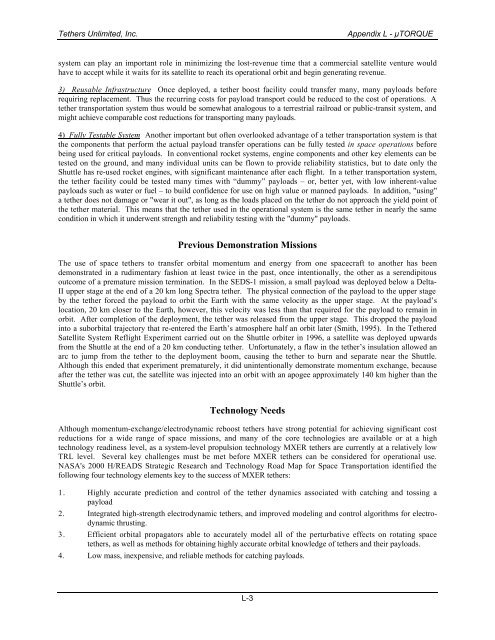Moon & Mars Orbiting Spinning Tether Transport - Tethers Unlimited
Moon & Mars Orbiting Spinning Tether Transport - Tethers Unlimited
Moon & Mars Orbiting Spinning Tether Transport - Tethers Unlimited
Create successful ePaper yourself
Turn your PDF publications into a flip-book with our unique Google optimized e-Paper software.
<strong>Tether</strong>s <strong>Unlimited</strong>, Inc.Appendix L - µTORQUEsystem can play an important role in minimizing the lost-revenue time that a commercial satellite venture wouldhave to accept while it waits for its satellite to reach its operational orbit and begin generating revenue.3) Reusable Infrastructure Once deployed, a tether boost facility could transfer many, many payloads beforerequiring replacement. Thus the recurring costs for payload transport could be reduced to the cost of operations. Atether transportation system thus would be somewhat analogous to a terrestrial railroad or public-transit system, andmight achieve comparable cost reductions for transporting many payloads.4) Fully Testable System Another important but often overlooked advantage of a tether transportation system is thatthe components that perform the actual payload transfer operations can be fully tested in space operations beforebeing used for critical payloads. In conventional rocket systems, engine components and other key elements can betested on the ground, and many individual units can be flown to provide reliability statistics, but to date only theShuttle has re-used rocket engines, with significant maintenance after each flight. In a tether transportation system,the tether facility could be tested many times with “dummy” payloads – or, better yet, with low inherent-valuepayloads such as water or fuel – to build confidence for use on high value or manned payloads. In addition, "using"a tether does not damage or "wear it out", as long as the loads placed on the tether do not approach the yield point ofthe tether material. This means that the tether used in the operational system is the same tether in nearly the samecondition in which it underwent strength and reliability testing with the "dummy" payloads.Previous Demonstration MissionsThe use of space tethers to transfer orbital momentum and energy from one spacecraft to another has beendemonstrated in a rudimentary fashion at least twice in the past, once intentionally, the other as a serendipitousoutcome of a premature mission termination. In the SEDS-1 mission, a small payload was deployed below a Delta-II upper stage at the end of a 20 km long Spectra tether. The physical connection of the payload to the upper stageby the tether forced the payload to orbit the Earth with the same velocity as the upper stage. At the payload’slocation, 20 km closer to the Earth, however, this velocity was less than that required for the payload to remain inorbit. After completion of the deployment, the tether was released from the upper stage. This dropped the payloadinto a suborbital trajectory that re-entered the Earth’s atmosphere half an orbit later (Smith, 1995). In the <strong>Tether</strong>edSatellite System Reflight Experiment carried out on the Shuttle orbiter in 1996, a satellite was deployed upwardsfrom the Shuttle at the end of a 20 km conducting tether. Unfortunately, a flaw in the tether’s insulation allowed anarc to jump from the tether to the deployment boom, causing the tether to burn and separate near the Shuttle.Although this ended that experiment prematurely, it did unintentionally demonstrate momentum exchange, becauseafter the tether was cut, the satellite was injected into an orbit with an apogee approximately 140 km higher than theShuttle’s orbit.Technology NeedsAlthough momentum-exchange/electrodynamic reboost tethers have strong potential for achieving significant costreductions for a wide range of space missions, and many of the core technologies are available or at a hightechnology readiness level, as a system-level propulsion technology MXER tethers are currently at a relatively lowTRL level. Several key challenges must be met before MXER tethers can be considered for operational use.NASA's 2000 H/READS Strategic Research and Technology Road Map for Space <strong>Transport</strong>ation identified thefollowing four technology elements key to the success of MXER tethers:1. Highly accurate prediction and control of the tether dynamics associated with catching and tossing apayload2. Integrated high-strength electrodynamic tethers, and improved modeling and control algorithms for electrodynamicthrusting.3. Efficient orbital propagators able to accurately model all of the perturbative effects on rotating spacetethers, as well as methods for obtaining highly accurate orbital knowledge of tethers and their payloads.4. Low mass, inexpensive, and reliable methods for catching payloads.L-3









